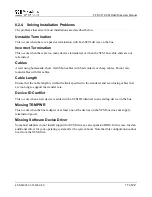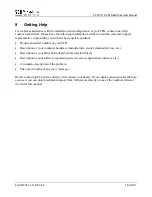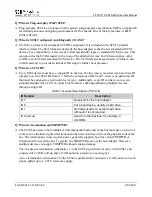
FFD 3.5
"
SCSI Flash Disk User Manual
45-SR-001-01-7L REV 4.0
19 of 22
10 Frequently Asked Questions (FAQs) About SCSI
Q: What is SCSI?
A: SCSI (Small Computer System Interface) is a general-purpose, parallel bus system. It originated
with Shugart’s 1979’ SASI (Shugart Associates System Interface), and Shugart and NCR
presented it to the ANSI in 1981. It became official in 1986, when the ANSI-committee X3T9.2
defined the SCSI-1 spec as Document X3.131-1986.
SCSI is now an acknowledged and very well standardized multipurpose interface in all its flavors.
SCSI supports a wide variety of devices, including hard disks, removable disks, magneto-optical
devices, tape drives, printers, processors, WORMs, CD-ROMs, scanners, medium-changers
(jukeboxes), and communications devices.
Q: What is SCSI-1?
A: SCSI-1 defined a universal 8-bit I/O-bus that allows connection of up to 8 devices, including the
host adapter. Every device must have a unique ID in the range of 0-7. SCSI-1 was a high-speed
bus system compared to the era’s existing peripheral devices.
Q: What is SCSI-2?
A: Although SCSI-1 was the first approved standard, it lacked various parameters and definitions.
This led to SCSI-2’s development and approval before SCSI-1 was even officially approved. In
1986, when SCSI-1 was officially approved, SCSI-2 already was far along in the development
process. The official SCSI-2 designation is X3.131-1994.
SCSI-2 provided a better formal definition, removed some oddities and obsolete items, added
some extensions, and most importantly, added the ability to double and even quadruple data
transfer speed on the SCSI bus with its Fast SCSI and Wide SCSI options.
Q: What is Fast SCSI?
A: Fast SCSI was defined as an option with SCSI-2. Despite the tendency of the market to define
Fast-SCSI as “different, but faster SCSI”, Fast SCSI is simply an additional synchronous data
transfer mode with tighter timing to achieve the 10MB/sec maximum data rate. As with any other
synchronous transfer mode, only data transfers are synchronous, while commands are transferred
asynchronously.
Q: What is Wide SCSI?
A: Wide SCSI is another SCSI-2 option . There are two defined types, 16 bit and 32 bit. Wide SCSI
can be combined with Fast SCSI to provide up to a 40MB/sec data rate.
The X3T9.2 committee defined a 68-pin SCSI cable for the 16-bit type, and a combination of a
standard 8-bit ‘A’ and a 68-pin ‘B’ cable for 16-bit and 32-bit Wide SCSI. Wide SCSI host
adapters can address standard SCSI devices if the correct adapter cable is used.




































